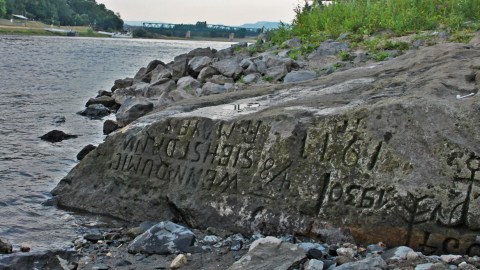Ominous ‘hunger stones’ reveal ancient warnings as extreme weather plagues Europe

It’s been a long, hot summer. Blazing new heat records were set across the globe; Scandinavia was particularly scorched, the United States endured a sultry July, and most of Europe is suffering from a severe drought. No matter how, or where, you slice it, the weather is terrible.
Indeed, in some parts of central Europe, it’s so dry that grim specters of droughts past are slowly emerging from the rivers, giving warnings to all those who can see them.
Hunger stones
Boulders inscribed with messages like “Wenn du mich siehst, dann weine” (If you see me, weep) are becoming visible as the Elbe’s water line drops; it has reached stunning lows as a result of the current drought. The stones warn of bad harvests, starvation, and high food prices alongside lists of previous droughts going back to 1417.
Another stone in Germany says “If you will again see this stone, so you will weep, so shallow the water was in the year 1417.” A dozen of these rocks are becoming visible all over central Europe, warning those who see them of woe.
What are these?
Hunger stones are rocks marked to show when the water level in a river has gotten low enough to signify disaster is at hand. They are found in historically German-speaking areas of central Europe. The rocks would normally be covered by the river, but during droughts, the water line goes down far enough to reveal the message. A typical rock “expressed that drought had brought a bad harvest, lack of food, high prices and hunger for poor people. Before 1900, the following droughts are commemorated on the stone: 1417, 1616, 1707, 1746, 1790, 1800, 1811, 1830, 1842, 1868, 1892, and 1893.”
So explains Rudolf Brázdil in a 2013 study of droughts in Czech-speaking areas of Europe over the last millennium. The oldest-known rock has markings going back to 1417, though the city of Pirna claims one from 1115 exists somewhere in the Elbe.
How dire are these warnings?
In the centuries since the stones were carved the water level has been considerably lowered by a dam, making the warnings visible under conditions which are not quite as cataclysmic as those which must have occurred when they were created.
The current drought, while not as horrible as others within the last 200 years, is severe enough to affect the soil; the high temperatures are drying it out in ways not seen before. This, according to a study published in Nature, “raises concerns about the consequences of extreme meteorological droughts in combination with soil moisture deficits enhanced by a warmer climate.”
The Elbe isn’t even the only river drying up; the mighty Danube has reached new lows, though no hunger stones have been found it in yet.
Are there warnings like this elsewhere?
The hunger stones are limited to German and Czech lands in Europe, but curious events caused by the drought are popping up across Europe. A 4,500-year-old henge in Ireland has been made visible again by the weather, as has a 300-year-old English garden and an entire German village.
As Earth continues to warm, weather conditions continue to become more extreme. What were once rare and dire warnings of famine and death are now visible on a semi-regular basis due to channelization and higher temperatures. While the warning it gives is not as fearsome as it once was, it still reminds us that a changing climate can have horrible consequences if we’re not careful.





